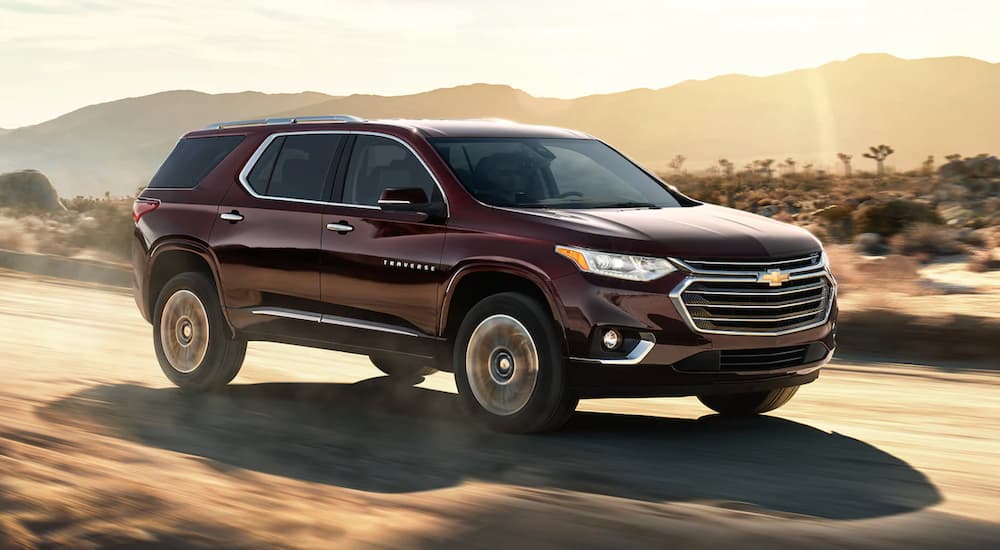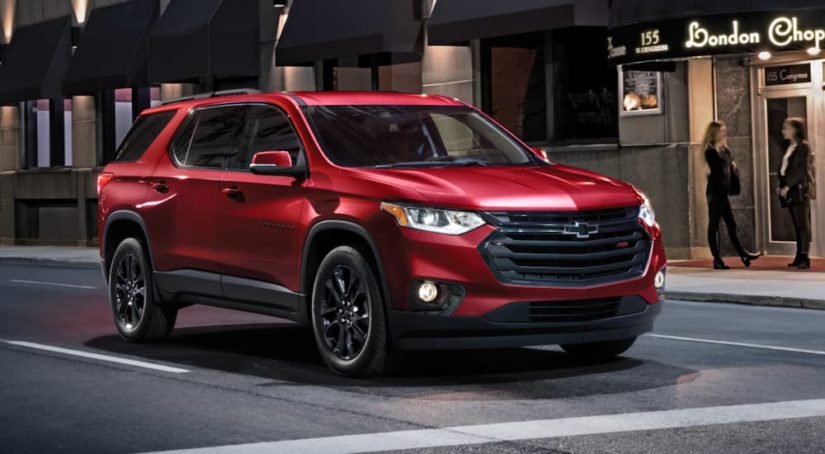For many years, three-row SUVs had a reputation for being sluggish to accelerate, cumbersome to drive, and so wildly inefficient that meant spending even more time and money at the gas pump to fill the land yacht’s tank and get it back on the road. Fortunately, advancements in the automotive industry are proving that full-size SUVs can be efficient and fun to drive without sacrificing size or capability. This shift is exactly what we see when we compare the 2021 Chevy Traverse vs 2021 Ford Explorer.
Chevy and Ford are setting new standards of performance, capability, and efficiency in the segment of full-size SUVs. The Traverse and the Explorer are two of the top-selling midsize models in the market, and you’ll soon see why. Here’s a closer look at seven factors to consider as you decide which model is best for you!
#1 – Pricing and Trim Options
The 2021 Chevy Traverse and the 2021 Ford Explorer offer great value because of their affordable prices and plethora of features. If you’re looking only at pricing and trim options, the Traverse wins by a landslide with a starting price of $29,800 and seven different trims that range from the L, LS, and LT to the RS, Premier, and High Country.
Ford also gives you seven choices in the Explorer lineup, starting with the base trim at $32,925. From there, you can upgrade to the XLT, Limited, Timberline, ST, King Ranch, or Platinum trims, all of which feature a progressive suite of features and luxuries. However, the Traverse is always less expensive.
#2 – Power and Performance
Power and performance certainly aren’t lacking on either the 2021 Traverse or the 2021 Explorer. Chevy outfits the Traverse with a 3.6-liter engine that’s paired with a 9-speed automatic transmission to deliver 310 horsepower and 266 lb-ft of torque. This power makes the Traverse quick to accelerate but doesn’t sacrifice the SUV’s efficiency, with front-wheel drive models averaging 18 MPG in the city and 27 MPG on the highway. All-wheel drive models average 17 MPG and 25 MPG, respectively.
Depending on the trim, you’ll find the 2021 Explorer is equipped with either a 2.3-liter EcoBoost four-cylinder engine or a 3.0-liter EcoBoost V6 engine and a 10-speed automatic transmission. The 2.3-liter delivers 300 horsepower and 310 lb-ft of torque. The 3.0-liter is designed to work with the Explorer’s intelligent four-wheel-drive system and maximizes performance and power on the Platinum and ST trims. On the Platinum trim, the engine produces 365 horsepower and 380 lb-ft of torque. However, the ST produces 400 horsepower and 415 lb-ft of torque, reflecting its performance-inspired design.

#3 – Dimensions and Cargo Space
As three-row SUVs, the Chevy Traverse and the Ford Explorer offer plenty of space whether you’re hauling passengers, cargo, or both. The 2021 Traverse offers seating for up to eight, while the Explorer offers seating for up to seven, depending on trim. The Traverse also has a longer wheelbase at 120.9 inches and is longer overall at 204.3 inches compared to the Explorer, which has a 119.1-inch wheelbase and stretches up to 199.3 inches long. The Traverse also boasts best-in-class cargo volume with a maximum capacity of 98.2 cubic feet compared to the Explorer at 87.8 cubic feet, which could easily mean the difference between hauling an extra piece of luggage, more groceries, or additional camping gear.
#4 – Connectivity
When it comes to staying connected to your busy life, you won’t have any trouble whether you’re behind the wheel of the Chevy Traverse or the Ford Explorer. Both SUVs offer a wide range of connectivity features that are housed in either Ford’s SYNC 3 infotainment system or the Chevy Infotainment 3 System. Intuitive touchscreen displays allow you to seamlessly sync your smartphone using Apple CarPlay or Android Auto and give you access to a variety of apps like navigation as well as an available 4G LTE Wi-Fi hotspot. These features make it easier for you to keep your hands on the wheel and your focus on the road.
#5 – Safety Features
You’ll have plenty of safety and driver-assist tools at your disposal, whether you’re behind the wheel of the Traverse or the Explorer. Every Traverse in the lineup comes with a tire pressure monitoring system that alerts you when your tire pressure is low, and driving is potentially hazardous. The SUV is also equipped with a standard rear vision camera that you can upgrade to HD Surround Vision that gives you a clear view around the entire Traverse.
Top-tier trims like the Premier and High Country offer a Rear Camera Mirror as well as enhanced tools like Adaptive Cruise Control and Enhanced Automatic Emergency Braking. Other safety and driver-assist tools include:
- Automatic Emergency Braking
- Forward Collision Alert
- Lane Keep Assist with Lane Departure Warning
- Front Pedestrian Braking
- IntelliBeam headlamps
- Following Distance Indicator
- Teen Driver
- HD Surround Vision
- Rear Cross Traffic Alert
- Rear Park Assist
The Explorer is equipped with many similar tools as part of the Co-Pilot360 suite. The suite includes a standard rearview camera and automatic headlamps as well as Ford’s Blind Spot Information System (BLIS) with Cross-Traffic Alert, Lane-Keeping System, Pre-Collision Assist with Automatic Emergency Braking with Pedestrian Detection, Ford Collision Warning, Dynamic Brake Support, and Post-Impact Braking.
If you’re looking for more advanced tools, you can upgrade to the Ford Co-Pilot360 Assist+ suite that includes Adaptive Cruise Control with Stop-and-Go and Lane Centering, Speed Sign Recognition, and Evasive Steering Assist. Other available upgrades include Active Park Assist 2.0, Reverse Brake Assist, a 360-degree camera with a front split-view, Intelligent Adaptive Cruise Control, Hill Descent Control, and BLIS with trailer tow coverage.

#6 – Owner Perks
Chevy and Ford both treat their customers exceptionally well, but you’ll enjoy a few more benefits as a loyal bowtie customer. Every new Traverse comes with a complimentary maintenance visit that you can take advantage of within the first year. This maintenance visit can be something like a routine oil change or a tire rotation, either of which Chevy will cover as a “thank you” for being a customer. Ford doesn’t offer a complimentary maintenance visit, but you’ll earn points when you purchase the Explorer and can use those points via the FordPass app toward maintenance, repairs, and accessories.
#7 – Warranty Coverage
Chevy and Ford want you to have confidence in your purchase long after you drive off the lot, and that means offering a great warranty program to cover major components and otherwise expensive repairs. Whether you purchase a Traverse or an Explorer, you’ll enjoy similar warranty coverage from Chevy and Ford, beginning with the standard bumper-to-bumper limited warranty that lasts three years or 36,000 miles. The models also come with a five-year or 60,000-mile powertrain warranty.
Complimentary roadside assistance is also available for both SUVs and provides everything from lockout service and towing to jump-starts and more. However, while Ford only provides roadside assistance for five years or 60,000 miles, Chevy goes a step further and will come to your aid for up to 100,000 miles after you purchased your Traverse.
The Choice is Yours
Now that you have a better idea of everything the 2021 Chevy Traverse and the 2021 Ford Explorer have to offer, which one would you choose? It’s time to look at what you want in a full-size SUV, the number of passengers you plan to haul, and where cargo volume ranks on your list of must-haves. Do you like the idea of a low-priced SUV that offers lots of seats and cargo room like the Traverse? Or are you willing to spend more right out of the gate to have a second powertrain option? The choice is yours, and it all comes down to which SUV will serve you better because both the 2021 Traverse and the 2021 Explorer are exceptional options.



